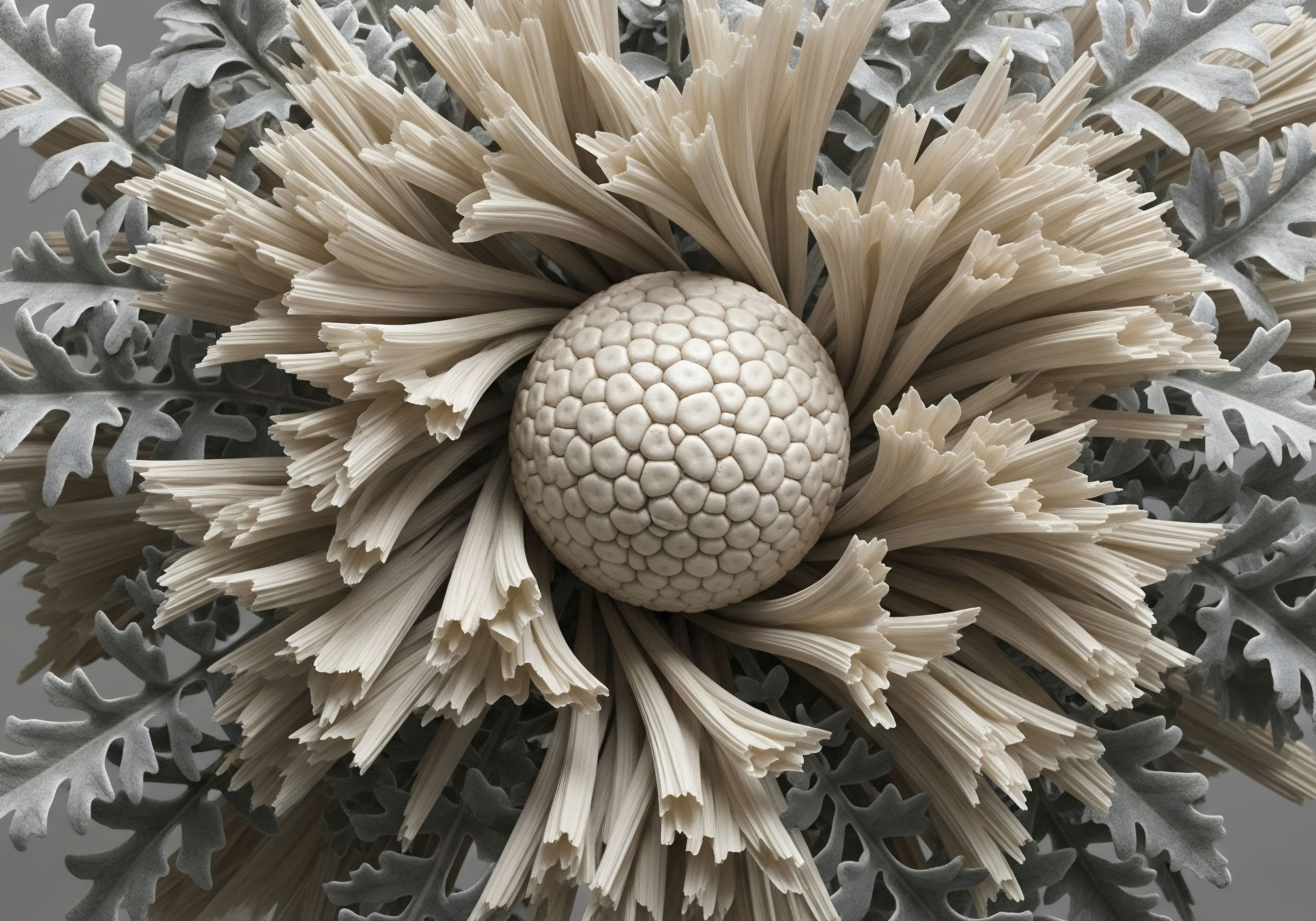

Fundamentals
The decision to transition away from a hormonal support protocol is a significant one, often accompanied by a sense of uncertainty. You may be wondering if your body can maintain its equilibrium, if the symptoms you once sought to alleviate will return. This is a valid and understandable concern.
The process you are considering is one of biological recalibration. After a period of receiving external hormonal signals, your body’s own communication networks, particularly the intricate system known as the Hypothalamic-Pituitary-Gonadal (HPG) axis, require a period of adjustment to resume their full, independent function.
Think of this axis as a sophisticated internal thermostat system that has been temporarily overridden. Lifestyle factors, specifically diet and exercise, are powerful tools that can guide this recalibration. They function as primary signaling inputs, providing the precise biological information your body needs to re-establish its own robust endocrine rhythm.
Your body possesses an inherent capacity for self-regulation. The transition off hormonal support is a process of re-engaging that innate intelligence. Diet and exercise provide the foundational support for this re-engagement.
They are the raw materials and the dynamic stimuli that encourage your endocrine glands to resume their natural production schedules and your cells to listen more attentively to the hormones you produce. This period is an active, directed conversation with your own physiology.
Every meal and every workout sends a message to your glands, your organs, and your brain. The goal is to make those messages consistent, clear, and supportive of the outcome you desire which is a stable, resilient, and self-sufficient hormonal state. This is about building a foundation of metabolic health that allows your endocrine system to function with stability and strength.
Strategic lifestyle inputs can guide the body’s endocrine system back to self-sufficient operation after hormonal support.

Understanding the Body’s Communication System
Your endocrine system operates on a principle of feedback. The brain, specifically the hypothalamus and pituitary gland, sends signaling hormones to your gonads (testes or ovaries) and adrenal glands. These peripheral glands then produce hormones like testosterone, estrogen, and cortisol.
When levels of these hormones in the blood are sufficient, they send a signal back to the brain to slow down its own signaling. This is a negative feedback loop, a constant and dynamic conversation that maintains hormonal balance.
When you introduce external hormones, the brain perceives high levels in the bloodstream and reduces its own output of signaling hormones (like LH and FSH). Consequently, the gonads reduce their own production. When the external source is removed, there is a lag time as the brain must first recognize the drop in hormone levels and then re-initiate its signaling to wake up the downstream glands. This is the critical window where lifestyle interventions provide their greatest benefit.

How Diet Speaks to Your Hormones
The food you consume provides the literal building blocks for your hormones. Steroid hormones, including testosterone and estrogen, are synthesized from cholesterol. Therefore, an adequate supply of healthy fats is a prerequisite for your body to even begin manufacturing these molecules.
Specific micronutrients, like zinc, magnesium, and vitamin D, act as essential cofactors in the enzymatic reactions that convert cholesterol into active hormones. A diet lacking these fundamental components is like asking a factory to produce goods without providing the necessary raw materials or the workers to operate the machinery.
Furthermore, managing blood sugar through a balanced intake of protein, fat, and complex carbohydrates is vital. Large spikes in insulin, the hormone that manages blood sugar, can disrupt the delicate balance of other hormones, placing additional stress on a system that is already working to recalibrate itself. A nutrient-dense diet communicates a message of safety and abundance to the body, encouraging it to invest resources in non-essential but quality-of-life functions like robust hormone production.

Exercise as an Endocrine Stimulant
Physical activity is another primary form of communication with your endocrine system. Different types of exercise send distinct signals. Resistance training, for example, creates a powerful stimulus for the production of anabolic hormones like testosterone and growth hormone. This occurs in response to the mechanical stress placed on muscle tissue.
The body interprets this stress as a demand for growth and repair, and it responds by upregulating the very hormones that support this process. This can be particularly beneficial when encouraging the testes or ovaries to increase their natural output.
Aerobic exercise, on the other hand, is exceptionally effective at improving insulin sensitivity and managing cortisol, the primary stress hormone. Chronic stress can suppress the HPG axis, so managing cortisol levels through regular, moderate-intensity activity helps to create a more favorable internal environment for reproductive hormone production. The physical work performed during exercise tells the body that it needs to be strong, resilient, and metabolically efficient, all of which are states supported by a well-functioning endocrine system.


Intermediate
Moving beyond the foundational concepts, the practical application of diet and exercise to support the transition from hormonal optimization protocols requires a specific and targeted approach. This is a period of physiological re-education, where strategic lifestyle choices can buffer the symptoms of hormonal fluctuation and accelerate the restoration of endogenous production.
The primary objective is to support the Hypothalamic-Pituitary-Gonadal (HPG) axis while simultaneously managing the stress-responsive Hypothalamic-Pituitary-Adrenal (HPA) axis. These two systems are deeply interconnected; excessive HPA axis activation (chronic stress) can actively suppress HPG axis function. Therefore, a successful transitional protocol is two-pronged ∞ it must provide the biochemical precursors for hormone synthesis and also create an internal environment that is conducive to that synthesis.
For men discontinuing Testosterone Replacement Therapy (TRT), often accompanied by agents like Gonadorelin or Anastrozole, the goal is to stimulate the testes to resume testosterone production and manage the potential for estrogen rebound. For women transitioning off low-dose testosterone or progesterone support, the focus is on stabilizing menstrual cycles, managing mood, and preserving bone density.
In both cases, the body has become accustomed to an external supply of hormones, leading to a downregulation of its natural signaling cascade. The lifestyle interventions detailed here are designed to directly counteract this effect, promoting a smoother and more efficient return to hormonal autonomy.

Architecting a Pro-Hormonal Diet
A diet designed to support endocrine function is built on the principle of nutrient density and hormonal communication. It supplies the necessary building blocks while helping to regulate the signaling pathways that can become dysregulated during this transition.

Macronutrient Strategy for Hormone Precursors
The macronutrient composition of your diet is the first level of control. Since steroid hormones are derived from cholesterol, dietary fat intake is of high importance. A diet that is too low in fat can compromise the body’s ability to synthesize testosterone and estrogen. The focus should be on a balanced intake of various types of healthy fats.
- Monounsaturated Fats ∞ Found in olive oil, avocados, and almonds, these fats are supportive of overall cardiovascular health and provide a stable source of lipid molecules.
- Polyunsaturated Fats (PUFAs) ∞ These include Omega-3 and Omega-6 fatty acids. Omega-3s, found in fatty fish like salmon and sardines, as well as flaxseeds and walnuts, are particularly important for their role in modulating inflammation. A lower inflammatory state is beneficial for optimal endocrine function. Some research suggests PUFA intake is associated with small increases in testosterone.
- Saturated Fats ∞ Found in sources like coconut oil, grass-fed butter, and red meat, saturated fats are also direct precursors for cholesterol production. A moderate intake of high-quality saturated fats is a necessary component of a hormone-supportive diet.
Protein intake is also a determining factor. Amino acids are the building blocks for peptide hormones, including the signaling hormones LH and FSH from the pituitary gland. Adequate protein is also essential for maintaining muscle mass, which is itself an endocrine organ. Finally, carbohydrate sources should be primarily complex and fiber-rich, such as sweet potatoes, quinoa, and vegetables. This helps to ensure a steady glucose and insulin response, preventing the hormonal disruption that can accompany sharp blood sugar fluctuations.
A diet rich in diverse fats, adequate protein, and complex carbohydrates provides the essential precursors for endogenous hormone production.

Essential Micronutrients the Catalysts of Hormone Synthesis
While macronutrients provide the bulk materials, micronutrients are the spark plugs that make the engines run. Several vitamins and minerals are critical for the enzymatic processes of steroidogenesis (the creation of steroid hormones).
| Micronutrient | Biological Role in Hormone Regulation | Primary Dietary Sources |
|---|---|---|
| Zinc | Acts as a cofactor for enzymes involved in testosterone synthesis. Essential for pituitary gland function and the release of LH. | Oysters, beef, pumpkin seeds, lentils. |
| Magnesium | Plays a role in regulating the HPA axis and managing cortisol levels. It can also improve insulin sensitivity and support sleep quality. | Leafy green vegetables, almonds, dark chocolate, avocados. |
| Vitamin D | Functions as a steroid hormone itself. Receptors for Vitamin D are found on endocrine glands, and deficiency is linked to low testosterone in men. | Sunlight exposure, fatty fish, fortified milk, egg yolks. |
| Selenium | Crucial for thyroid hormone metabolism, which works in concert with the reproductive hormones. Also a potent antioxidant. | Brazil nuts, tuna, sardines, grass-fed beef. |

Structuring Exercise to Restore Endocrine Rhythms
The physical stress of exercise is a potent signal to the endocrine system. The key is to apply the right kind of stress at the right intensity to elicit the desired hormonal adaptation.

Resistance Training for Anabolic Signaling
Weightlifting and other forms of resistance training are powerful stimulators of the HPG axis. The protocol should focus on compound movements that recruit large muscle groups, such as squats, deadlifts, overhead presses, and rows. These exercises create the largest systemic demand for adaptation.
- Intensity and Volume ∞ Working in a range of 70-85% of your one-repetition maximum for sets of 5-10 repetitions is generally effective for stimulating testosterone and growth hormone release. Adequate training volume (number of sets and reps) is necessary to trigger a significant response.
- Rest Periods ∞ Shorter rest periods (60-90 seconds) can enhance the post-exercise growth hormone response, while slightly longer rest periods may be more beneficial for strength and testosterone.
- Frequency ∞ Training 3-4 times per week allows for sufficient stimulus without over-stressing the system, providing adequate time for recovery and adaptation.

Cardiovascular Exercise for Metabolic and Stress Regulation
Cardiovascular exercise should be used strategically to improve metabolic health and manage HPA axis activity. The type and intensity matter significantly.
Zone 2 training, which involves maintaining a heart rate at which you can still hold a conversation, is particularly effective. This low-intensity, steady-state work improves mitochondrial efficiency and enhances the body’s ability to use fat for fuel. It is also highly effective at managing stress and lowering resting cortisol levels without causing a large spike in exercise-induced cortisol.
High-Intensity Interval Training (HIIT) can be used sparingly (1-2 times per week) to provide a potent stimulus for improving insulin sensitivity. However, due to its demanding nature, excessive HIIT can be perceived by the body as a significant stressor, potentially elevating cortisol and working against the goal of HPG axis restoration.
By combining a nutrient-dense diet rich in hormonal precursors with a structured exercise program that sends clear signals for anabolic activity and stress modulation, you can create a powerful, synergistic effect. This integrated approach provides robust support for the body as it transitions away from external hormonal protocols and works to re-establish its own inherent, resilient endocrine function.


Academic
The transition from exogenous hormonal support represents a complex challenge in clinical physiology, necessitating a deep understanding of neuroendocrine feedback mechanisms and the molecular interplay between lifestyle inputs and steroidogenesis. When a protocol such as TRT is discontinued, the primary clinical objective is to facilitate the recovery of the Hypothalamic-Pituitary-Gonadal (HPG) axis from a state of induced suppression.
This suppression is a direct consequence of the negative feedback exerted by supraphysiological levels of exogenous androgens on gonadotropin-releasing hormone (GnRH) pulse generation in the hypothalamus and subsequent luteinizing hormone (LH) and follicle-stimulating hormone (FSH) secretion from the anterior pituitary. The efficacy of lifestyle-based interventions in this context is predicated on their ability to modulate this neuroendocrine axis at multiple levels, from the provision of substrate for steroid synthesis to the regulation of central signaling pathways.
The core of the issue lies in the re-establishment of pulsatile GnRH secretion. Chronic exposure to exogenous testosterone flattens the endogenous hormonal rhythm and reduces the sensitivity of pituitary gonadotrophs. The recovery timeline is highly variable and depends on the duration of therapy, dosage, and individual genetic factors.
Lifestyle factors, specifically targeted nutritional biochemistry and precise exercise prescription, can be viewed as potent non-pharmacological agonists for pathways that support HPG axis reactivation and overall metabolic homeostasis. This section will examine the specific molecular mechanisms through which diet and exercise can support this complex biological process.

Nutritional Biochemistry as a Tool for Endogenous Steroidogenesis
The synthesis of all steroid hormones begins with the 27-carbon molecule, cholesterol. The enzymatic cascade that converts cholesterol into testosterone, estradiol, and other steroids is known as steroidogenesis, and it is highly dependent on the availability of specific substrates and cofactors provided by the diet.

The Central Role of Dietary Lipids in Steroid Hormone Synthesis
Cholesterol is the obligate precursor for steroidogenesis. It is converted to pregnenolone by the enzyme cholesterol side-chain cleavage enzyme (P450scc, or CYP11A1) within the mitochondria of steroidogenic cells in the Leydig cells of the testes and the theca cells of the ovaries.
While the body can synthesize cholesterol de novo in the liver, dietary intake of fats influences the circulating lipid pool available to these cells. Low-fat diets have been correlated with reductions in circulating testosterone levels, likely due to substrate limitation.
The composition of dietary fats also has a mechanistic influence. Polyunsaturated fatty acids (PUFAs), particularly omega-3 fatty acids like eicosapentaenoic acid (EPA) and docosahexaenoic acid (DHA), are incorporated into the phospholipid membranes of cells. This can alter membrane fluidity and the function of embedded receptors, including those for LH.
Furthermore, PUFAs are precursors to eicosanoids, signaling molecules that modulate inflammation. A pro-inflammatory state, characterized by elevated cytokines like TNF-α and IL-6, can directly suppress Leydig cell function and testosterone production. By promoting the synthesis of anti-inflammatory prostaglandins and leukotrienes, a diet rich in omega-3s can attenuate this inflammatory suppression of steroidogenesis. Research has indicated that higher PUFA intake is associated with minor increases in testosterone concentrations in healthy women, suggesting a direct modulatory role.
Specific dietary fatty acids serve as both foundational substrates for hormone synthesis and as signaling molecules that modulate inflammatory pathways impacting endocrine function.

What Are the Molecular Mechanisms of Exercise on the HPG Axis?
Exercise initiates a cascade of neuroendocrine responses that can directly influence the HPG axis. The nature of this influence is dictated by the modality, intensity, and duration of the exercise stimulus. Strenuous, prolonged exercise, especially in a state of low energy availability, is known to suppress the HPG axis.
This is mediated in part by the activation of the HPA axis and the release of corticotropin-releasing hormone (CRH), which has an inhibitory effect on GnRH neurons. Conversely, acute bouts of resistance exercise have been shown to transiently increase serum testosterone levels. This response is thought to be mediated by several mechanisms, including increased sympathetic nervous system outflow to the testes, lactate-induced potentiation of LH release, and improved testicular blood flow.
From a long-term adaptive perspective, consistent resistance training increases the density of androgen receptors in skeletal muscle tissue. This enhanced sensitivity to circulating androgens can create a stronger feed-forward signal for the maintenance of HPG axis tone. Muscle tissue itself acts as an endocrine organ, releasing signaling molecules called myokines in response to contraction.
Myokines such as irisin and brain-derived neurotrophic factor (BDNF) have complex interactions with the central nervous system and may influence hypothalamic function. The goal during the post-hormone support transition is to leverage exercise as a form of eustress a beneficial stressor that stimulates the system without causing the chronic HPA activation that would further suppress the HPG axis.
| Exercise Modality | Primary Neuroendocrine Effect | Mechanism of Action | Application in Post-Hormonal Transition |
|---|---|---|---|
| Heavy Resistance Training | Acute increase in Testosterone and Growth Hormone. Increased androgen receptor sensitivity over time. | Increased sympathetic outflow, lactate production, and mechanical tension leading to anabolic signaling. | Provides a direct stimulus for HPG axis activation and promotes maintenance of muscle mass. |
| Low-Intensity Steady State (Zone 2) | Decreased basal cortisol levels. Improved insulin sensitivity and mitochondrial function. | Upregulation of aerobic enzymes and fatty acid oxidation pathways. Low-level stress that promotes adaptation without significant HPA axis activation. | Manages the suppressive effects of chronic stress on the HPG axis and improves metabolic health. |
| High-Intensity Interval Training (HIIT) | Potent stimulus for improved insulin sensitivity and acute cortisol release. | Rapid ATP depletion and significant metabolic stress leading to broad adaptations. | To be used sparingly to avoid excessive HPA axis stimulation that could inhibit HPG axis recovery. |
In conclusion, supporting the body’s transition from exogenous hormonal therapy is a clinical challenge that can be substantially aided by precise, mechanistically informed lifestyle interventions. A nutritional strategy focused on providing the lipid substrates and micronutrient cofactors for steroidogenesis directly supports the biochemical capacity of the gonads.
Simultaneously, a structured exercise program that balances anabolic signaling from resistance training with the HPA-modulating effects of aerobic conditioning can help re-establish central drive to the HPG axis. This integrated, systems-biology approach provides a robust framework for facilitating a return to endogenous hormonal resilience.

References
- Whitten, C. G. & G. A. Hand. “Exercise, Training, and the Hypothalamic-Pituitary-Gonadal Axis in Men and Women.” Comprehensive Physiology, vol. 6, no. 4, 2016, pp. 1589-1619.
- Mumford, S. L. et al. “Dietary fat intake and reproductive hormone concentrations and ovulation in regularly menstruating women.” The American Journal of Clinical Nutrition, vol. 103, no. 3, 2016, pp. 868-877.
- Pappa, Dimitra, et al. “Effect of an ultra-distance foot race on the hypothalamic-pituitary testicular adrenocortical axes insulin growth factor levels ∞ distinct patterns of suppression, stimulation and recovery.” Annals of Translational Medicine, vol. 5, no. 21, 2017, p. 423.
- Holmes, D. et al. “Dietary fat intake and endogenous sex steroid hormone levels in postmenopausal women.” Journal of Clinical Oncology, vol. 18, no. 21, 2000, pp. 3668-3676.
- U.S. Women’s Medical Center. “Lifestyle Tips For Hormone Replacement Therapy.” US Women’s Medical Center Blog, 2023.
- Hormones by Design. “HRT, Lifestyle, and Aging Gracefully ∞ A Synergistic Approach for Enhanced Well-Being.” Hormones by Design Blog, 8 Jan. 2024.
- Veldhuis, J. D. et al. “Enhanced Coupling Within Gonadotropic and Adrenocorticotropic Axes by Moderate Exercise in Healthy Men.” The Journal of Clinical Endocrinology & Metabolism, vol. 99, no. 8, 2014, pp. E1431-E1437.
- “The Biochemistry of Steroid Hormones.” Number Analytics, 5 June 2025.
- “Lipid – Steroid Hormones, Synthesis, Receptors.” Britannica, 6 July 2025.

Reflection
The information presented here provides a map of the biological terrain you are preparing to navigate. It details the pathways, the signals, and the raw materials your body uses to construct its own state of hormonal wellness. Understanding these mechanisms is the first step in moving from a position of passive recipient to one of active participant in your own health.
The data shows that your daily choices regarding what you eat and how you move are not incidental. They are direct inputs into the complex calculus of your endocrine system. As you consider this transition, the question shifts from ‘Can the body recover?’ to ‘How can I best facilitate that recovery?’.
This knowledge is a tool, and like any tool, its true value is realized in its application. Your unique physiology, history, and goals will shape how you apply these principles. The path forward is one of informed, deliberate action, grounded in a deeper understanding of the remarkable, self-regulating system you inhabit.



